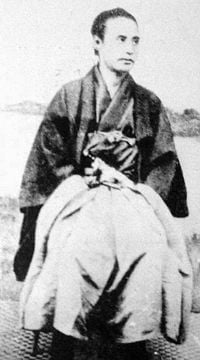Katsu Kaishu
| Katsu Kaishū | |
|---|---|
| 1823-1899 | |
 Katsu Kaishū | |
| Nickname | Awa Katsū |
| Place of birth | Edo, Japan |
| Place of death | Japan |
| Allegiance | Imperial Japan |
| Years of service | 1855-1868 (Tokugawa); 1872-1899 (Imperial Japan) |
| Rank | Naval officer |
| Commands held | Kanrin-maru (warship) Kobe naval school Vice Minister Navy Minister |
| Battles/wars | Boshin War |
| Other work | military theorist |
Katsu Kaishū (勝 海舟 Awa Katsu; Kaishū; Rintaro; Yoshikuni 1823-99) was a Japanese naval officer and statesman during the Late Tokugawa shogunate and the Meiji period. Kaishū was a nickname which he took from a piece of calligraphy (Kaishū Shooku 海舟書屋) by Sakuma Shōzan. His actual name was Rintarō.
Katsu Kaishū eventually rose to occupy the position of commissioner (Gunkan-bugyo) in the Tokugawa navy. He is particularly known for his role in the surrender of Edo.
Early life
Katsu was born in Edo (present day Tokyo) to a low-ranking retainer of the Tokugawa Shogun. His father, Katsu Kokichi, was the ill-behaved head of a minor samurai family, who was forced to abdicate the headship of his family to Rintarō/Kaishū when the latter was only 15. As a youth Katsu studied Dutch and other aspects of European military science, and was eventually appointed translator by the government when European powers attempted to open contact with Japan. Katsu developed the reputation as an expert in western military technology.
Under the advisement of Dutch advisors, he served as director of training for the Nagasaki Naval Center together with Nagai Naoyuki between 1855 until 1859 when he was commissioned an officer in the shogunal navy the following year.
Military service
In 1860, Katsu was assigned to command the Kanrin-maru, and (with assistance from US naval officer Lt. John M. Brooke), to escort the first Japanese delegation to San Francisco, California en route to Washington, DC for the formal ratification of the Harris Treaty. The Kanrin Maru, built by the Dutch, was Japan's first steam-powered warship, and its voyage across the Pacific Ocean was meant to signal that Japan had mastered modern sailing and shipbuilding technology. Kaishū remained in San Francisco for nearly two months, observing American society, culture and technology. Following returning to Japan, Katsu held a series of high ranking posts in the Tokugawa navy, arguing before government councils in favor of a unified Japanese naval force disregarding traditional hereditary domains and professionally trained officers. During his command as director of the Kobe Naval School, the institute would become a major source of activity for progressive thinking and reformists between 1863 and 1864.
In 1866, Katsu was appointed negotiator between the bakufu forces and the anti-shogunal domain of Chōshū, and later served as chief negotiator for the Tokugawa bakufu, ensuring a relatively peaceful and orderly transition of power in the Meiji Restoration.
Although sympathetic to the anti-Tokugawa cause, Katsu remained loyal to the Tokugawa bakufu during the Boshin War. After the collapse of the Tokugawa forces in late 1867, Katsu negotiated the surrender of Edo castle to Saigō Takamori and the Satcho Alliance on 3 May 1868. Katsu followed the last Shogun, Tokugawa Yoshinobu, into exile in Shizuoka.
Later years
Katsu returned briefly to government service as Vice Minister of the Imperial Japanese Navy in 1872, followed by first Minister of the Navy from 1873 until 1878. He was the most prominent of the former Tokugawa retainers who found employment with in the new Meiji government. Although his influence within the navy was minimal, as the Navy was largely dominated by a core of Satsuma officers, Katsu served in a senior advisory capacity on national policy. During the next two decades, Katsu served on the Privy Council and wrote extensively on naval issues before his death in 1899.
In 1887, he was elevated to the title of hakushaku (count) in the kazoku peerage system.
Katsu recorded his memoirs in the book Hikawa Seiwa.
ReferencesISBN links support NWE through referral fees
- Jansen, Marius B. Sakamoto Ryoma and the Meiji Restoration Princeton, New Jersey, 1961.
- Katsu, Kokichi; Teruko, Craig (translator). Musui's Story: The Autobiography of a Tokugawa Samurai University of Arizona Press, 1988.
External link
ja:勝海舟 zh:胜海舟
Credits
New World Encyclopedia writers and editors rewrote and completed the Wikipedia article in accordance with New World Encyclopedia standards. This article abides by terms of the Creative Commons CC-by-sa 3.0 License (CC-by-sa), which may be used and disseminated with proper attribution. Credit is due under the terms of this license that can reference both the New World Encyclopedia contributors and the selfless volunteer contributors of the Wikimedia Foundation. To cite this article click here for a list of acceptable citing formats.The history of earlier contributions by wikipedians is accessible to researchers here:
The history of this article since it was imported to New World Encyclopedia:
Note: Some restrictions may apply to use of individual images which are separately licensed.